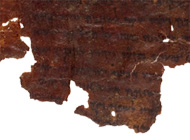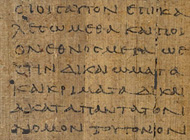From Scroll to Codex: The earliest Hebrew scriptures
Until the fourth century, the standard form of a book for people was not a book at all. Rather, it was a roll—also called a scroll or bookroll—made of papyrus or animal skin on which a text was inscribed by hand. The earliest books of the Hebrew Bible survive today in scroll form. Known as the Dead Sea Scrolls, they were discovered in the Judaean Desert in the 1940s and include the Second Isaiah Scroll.
The Hebrew Bible—the thirty-nine books of the Torah, Nevi'im (Prophets), and Ketuvim (Writings)—was formed over a number of centuries. Between 500 and 900 C.E. scribes called the Masoretes established the pronunciation of words and the division of paragraphs and verses.
But the Hebrew Bible was not the only version in circulation. Many Jews and early Christians used a Greek translation, probably begun during the third century B.C.E. It was called the Septuaginta (Latin for "seventy") because according to legend, it was produced by seventy-two Jewish scholars. It included fifteen texts omitted from the Hebrew Bible and was the basis for many of the manuscripts in this exhibition.
In the first century, a new kind of publication appeared: the codex or leaf-book, a series of pages bound together at one edge and protected by covers. Its increasing popularity was directly connected to the formation of the Christian Bible.
Codices made cross-referencing between biblical books much easier and were more readily portable than scrolls. These benefits appealed to Christian audiences, particularly during times of persecution.
Because Christianity emerged as a sectarian type of Judaism rather than an independent religion, the Bible of the earliest Christians was the Bible of Judaism. Two codices on display in this exhibition, the Aleppo Codex and the St. Petersburg Pentateuch, formed the basis for what became the standard text of the Hebrew Bible.
As Christianity spread throughout the Roman Empire, the codex gradually displaced the scroll as the medium for non-Christian texts as well. By the time Christianity was established as the empire's official religion in the fourth century, the codex had become standard. This was a monumental change in the history of the book, comparable to the invention of movable type in the fifteenth century or the electronic text of the modern era.
The Earliest Christian Scriptures
Composed in Greek, early Christian texts were not intended as "biblical" books as such but were written in response to the needs of local Christian communities. Ultimately many of these writings came to form the New Testament, including the canonical gospels attributed to Matthew, Mark, Luke, and John. But that was the result of a long process not imagined by their authors.
Perhaps because they relied on the scriptures of Judaism, early Christians were slow to produce writings of their own. The earliest to survive are the letters of Saint Paul (50–60 C.E.) and the Gospel according to Mark (65–70 C.E.). These were followed around 80–90 C.E. by the longer Gospels of Matthew and Luke (the latter accompanied by the Acts of the Apostles), along with a lost source that scholars call "Q," which contained sayings and parables of Jesus and some episodes from his life. Saint John's Gospel appeared around 85–95 C.E., as did the letters of James, Peter, and John; Paul's letter to the Hebrews; and the Revelation of Saint John (the Apocalypse).
Christian writings then proliferated, with more letters and revelations/apocalypses as well as a variety of gospels eventually omitted from the Christian Bible. These include the Unknown or Egerton Gospel and the Gospel of Thomas, both on display in this exhibition. Other writings have been attributed to Christians and Gnostics, a sect that sought mystical enlightenment as a means to salvation.

|
 |
Click on an image for details:

The Dead Sea Scrolls: Isaiah Scroll

Earliest Numbers and Deuteronomy

The Gospel of Thomas (Logia Iesou)

Washington Ms. V - The Minor Prophets
|